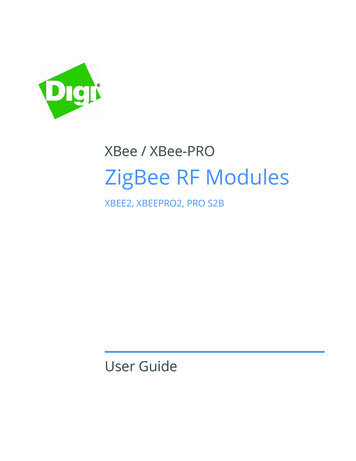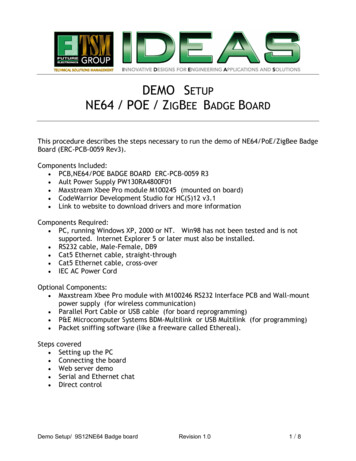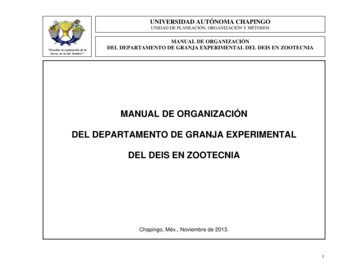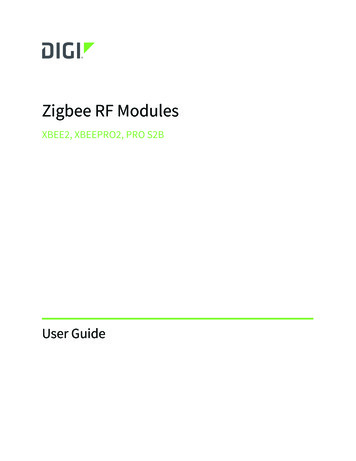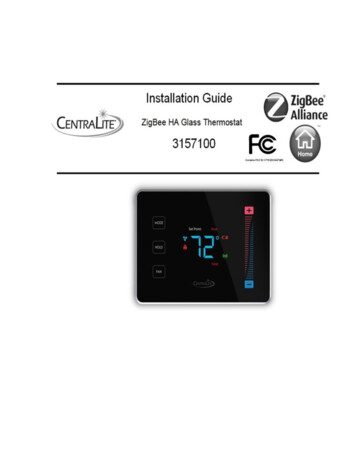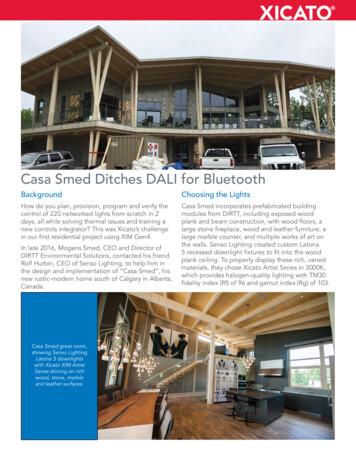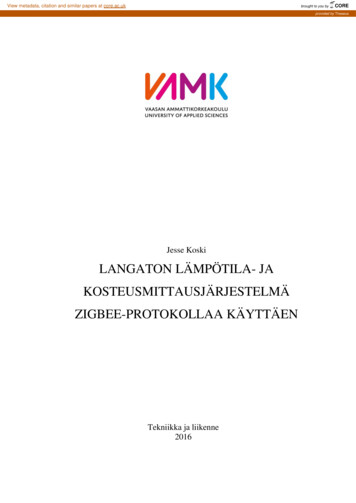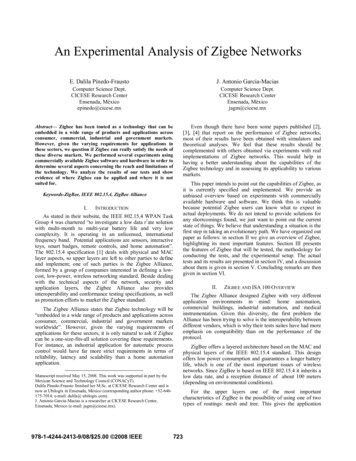
Transcription
An Experimental Analysis of Zigbee NetworksE. Dalila Pinedo-FraustoJ. Antonio Garcia-MaciasComputer Science Dept.CICESE Research CenterEnsenada, Méxicoepinedo@cicese.mxComputer Science Dept.CICESE Research CenterEnsenada, Méxicojagm@cicese.mxEven though there have been some papers published [2],[3], [4] that report on the performance of Zigbee networks,most of their results have been obtained with simulators andtheoretical analyses. We feel that these results should becomplemented with others obtained via experiments with realimplementations of Zigbee networks. This would help inhaving a better understanding about the capabilities of theZigbee technology and in assessing its applicability to variousmarkets.Abstract— Zigbee has been touted as a technology that can beembedded in a wide range of products and applications acrossconsumer, commercial, industrial and government markets.However, given the varying requirements for applications inthese sectors, we question if Zigbee can really satisfy the needs ofthese diverse markets. We performed several experiments usingcommercially available Zigbee software and hardware in order todetermine several aspects concerning the reach and limitations ofthe technology. We analyze the results of our tests and showevidence of where Zigbee can be applied and where it is notsuited for.Keywords-ZigBee, IEEE 802.15.4, ZigBee AllianceI.INTRODUCTIONAs stated in their website, the IEEE 802.15.4 WPAN TaskGroup 4 was chartered “to investigate a low data r1ate solutionwith multi-month to multi-year battery life and very lowcomplexity. It is operating in an unlicensed, internationalfrequency band. Potential applications are sensors, interactivetoys, smart badges, remote controls, and home automation”.The 802.15.4 specification [1] deals with physical and MAClayer aspects, so upper layers are left to other parties to defineand implement; one of such parties is the Zigbee Alliance,formed by a group of companies interested in defining a lowcost, low-power, wireless networking standard. Beside dealingwith the technical aspects of the network, security andapplication layers, the Zigbee Alliance also providesinteroperability and conformance testing specifications, as wellas promotion efforts to market the Zigbee standard.The Zigbee Alliance states that Zigbee technology will be“embedded in a wide range of products and applications acrossconsumer, commercial, industrial and government marketsworldwide”. However, given the varying requirements ofapplications for these sectors, it is only natural to ask if Zigbeecan be a one-size-fits-all solution covering these requirements.For instance, an industrial application for automatic processcontrol would have far more strict requirements in terms ofreliability, latency and scalability than a home automationapplication.Manuscript received May 15, 2008. This work was supported in part by theMexican Science and Technology Council (CONACyT).Dalila Pinedo-Frausto finished her M.Sc. at CICESE Research Center and isnow at Ubilogix in Ensenada, México (corresponding author phone: 52-646175-7014; e-mail: dalila@ ubilogix.com).J. Antonio Garcia-Macias is a researcher at CICESE Research Center,Ensenada, Mexico (e-mail: jagm@cicese.mx).978-1-4244-2413-9/08/ 25.00 2008 IEEEThis paper intends to point out the capabilities of Zigbee, asit is currently specified and implemented. We provide anunbiased overview based on experiments with commerciallyavailable hardware and software. We think this is valuablebecause potential Zigbee users can know what to expect inactual deployments. We do not intend to provide solutions forany shortcomings found, we just want to point out the currentstate of things. We believe that understanding a situation is thefirst step in taking an evolutionary path. We have organized outpaper as follows: in section II we give an overview of Zigbee,highlighting its most important features. Section III presentsthe features of Zigbee that will be tested, the methodology forconducting the tests, and the experimental setup. The actualtests and its results are presented in section IV, and a discussionabout them is given in section V. Concluding remarks are thengiven in section VI.II.ZIGBEE AND ISA 100 OVERVIEWThe Zigbee Alliance designed Zigbee with very differentapplication environments in mind: home automation,commercial buildings, industrial automation, and medicalinstrumentation. Given this diversity, the first problem theAlliance has been trying to solve is the interoperability betweendifferent vendors, which is why their tests suites have had moreemphasis on compatibility than on the performance of theprotocol.ZigBee offers a layered architecture based on the MAC andphysical layers of the IEEE 802.15.4 standard. This designoffers low power consumption and guarantees a longer batterylife, which is one of the most important issues of wirelessnetworks. Since ZigBee is based on IEEE 802.15.4 it inherits alow data rate, and a reception distance of about 100 meters(depending on environmental conditions).For the upper layers one of the most importantcharacteristics of ZigBee is the possibility of using one of twotypes of routings: mesh and tree. This gives the application723
The protocol also offers a framework application to makeeasier and faster the development of simple standardapplications. Also, in order to promote the reuse of alreadyexisting functionalities, libraries and profiles have been createdto facilitate the construction of the most frequently neededdevices within the application environments that ZigBee hasbeen created for. This is why ZigBee can not only beconsidered as a simple set of commands for the communicationbetween sensor nodes, but as a whole framework that allowsthe creation of standard devices, assuring the interoperabilitybetween different manufacturers.Analogous to the IEEE 802.15.4 standard, devices in thenetwork are known as Full Function Devices (FFD) or ReducedFunction Devices (RFD). A ZigBee network has three types ofdevices: two of them, the coordinator (ZC) and the router (ZR),are FFD and there is a RFD called end device (ZED). The ZCis the only one that can form a ZigBee network and is uniquewithin the network. The ZR has the same routing capabilities asthe ZC, but can only join a network, never form it. A Zigbeeend device, or ZED, can only join the network and has nocapacity for routing, it also should always be associated to aparent to be able to communicate and its most importantcharacteristic is the capacity to shut down its radio duringdefined periods of time to save energy; while it is off itsassociated parent receives messages addressed to it and savesthem so that they can be delivered when the ZED radio isturned on and it requires data from its parent.The ZigBee architecture, showed in Figure 1. , has alayered design in which every layer offers services to the nexthigher layer through Service Access Points (SAPs). There aretwo kinds of SAPs: the Data Entity (DE), dedicated to thetransmission of data between layers, and the ManagementEntity (ME) for the transmission of control and servicesadministration commands.As mentioned before, the ZigBee protocol sits on top ofIEEE 802.15.4 PHY and MAC layers (Fig. 1). Its next higherlayer is the network layer (NWK) in charge of the formation ofthe network, addresses administration, routing, devicesdiscovery, as well as security application and services. On topof the NWK layer there is the Application Support Sublayer(APS) and the ZigBee Device Object (ZDO) with its verticalmanagement plane. The APS layer with its two SAPs (APSMEand APSDE) offers an interface between the NWK layer andthe upper layers; its main task is to generate the Protocol DataUnit (APDU). It is also in charge of group address filtration,secure transportation of messages, rejection of duplicates fromthe application, authentication of links, security keys, andadministration of devices to groups.The ZDO is a basic functionality class that offers aninterface between the application objects, the profile and theAPS layer. It initializes the APS and NWK layers and theSecurity Services Provider (SSP), this last one used to encryptand decrypt messages. The main objective of the ZDO is theadministration of basic functions of any application device andit is also an interface to the variety of functionalities of ZigBee.As mentioned before, the ZigBee protocol contains anapplication framework for the application objects. To definethe framework for the specific application environment there isan application profile and a ZigBee Cluster Library (ZCL). Theapplication profile describes the types of devices and thespecific clusters from the ZigBee library needed to implement astandard functionality. A cluster is defined as the specificationof a distributed functionality in two types of devices: a serverand a client. This way a developer can use the standardfunctionality of the ZCL and also create its own clusters for hisown profile, these clusters can also be registered as part of theZigBee protocol and obtain an specific identification numberfor the profile.TABLE I.SafetyApplication ZigBee DeviceObject(ZDO)ZDOPublicI t erApplication Support SublayerNLDE-SAPZDOAPSME-SAPNLME-SAPNetwork LayerMLDE-SAPManagerNLME-SAPMonitoringMLME-SAPMAC 802.15.4PD-SAPPLME- SAPPHY 802.15.4Figure 1. ZigBee Architecture724ISA USAGE CLASSES FOR WIRELESS SENSOR NETWORKSPROTOCOLS.Class0:Emergencyaction(always critical)Class 1: Closed loop regulatory control(often critical)Class 2: Closed loop supervisory control(usually non-critical)Class3:Openloopcontrol(human in the loop)NOTE Batch levels* 3 & 4 could beclass 2, class 1 or even class 0,depending on function*Batch levels as defined by ISAS88; where L3 "unit" and L4 "process cell"Class 4: AlertingShort-termoperational consequence (e.g., eventbased Noimmediate operational consequence(e.g., history collection, sequence-ofevents, preventive maintenance)Importance of messagetimeliness increasesdesigner much more freedom to get the maximum gain out ofeach option depending on the very own needs of the solutionthey develop.
Since Zigbee was conceived for a wide range of wirelessapplications, we decided to compare with a standard definedfor a focused set of requirements, more precisely for the strictrequirements of industrial applications. ISA a leaderorganization in standards for automation formed in 2005 hasformed the ISA 100, a committee for wireless systems forindustrial automation. In 2006 this committee delivered twodrafts of requirements for industrial wireless sensors networks[7] and [8], which we used as a guideline for the design of ourtests. In these drafts, ISA also presented its usage classificationof industrial wireless sensor networks. We will eventually referto this classification when discussing the results of testingZigBee.III.EXPERIMENTAL SETUPFor our experiments we used the BeeKit package offered byFreescale; this package features a user-friendly environment toaid in the creation of applications based on Freescale s SimpleMAC (SMAC), IEEE 802.15.4 PHY/MAC and BeeStackZigbee protocol stack. In order to have tests with a ZigBee likeapplication design, we used some of the ZigBee Alliance’s CountedPackets, an internal) and we implemented twomore commands to have full control over the application. Alsowe used Freescale’s ZigBee Test Client (ZTC) application tomeasure the quantity of data requests and confirms betweenlayers that passed through APSDE-SAP, NLDE-SAP andMLDE-SAP handlers. A tool that was used extensively duringour experiments is the Daintree network analyzer; thiscombines a USB device that captures packets in a wirelessnetwork for a configured channel and graphically shows thestructure and contents of Zigbee/802.15.4 packets. On thehardware side, we mostly used Panasonic's PAN802154module a communication device fully compliant with 2.4GHzISM band requirements, and ready to be used with Freescale'sZigBee protocol BeeStack. Also, for comparison in some testswe used Freescale’s 13192-EVBs. For maximum WiFinetworks noise avoidance, the experiments were done inchannel 26 of IEEE 802.15.4 standard.The outdoors experiments were conducted in a vast(approximately 1000 m2) and empty parking lot, in order toavoid interferences, and mounting the nodes on top of woodpoles with a height of over 1 meter. For the indoor experimentswe used the third floor of a 3-story building; distance tests wereconducted in a 50 m long hallway, other experiments wereconducted in a 6x25 m office space.IV.EXPERIMENTS AND RESULTSThe development of the tests was based on the idea ofverifying the actual capacity of the ZigBee protocol inindustrial control and monitoring applications. We first did arevision of the theoretical characteristics of 4 of the mostimportant wired sensor network protocols used today inindustry: Ethernet/IP, FF H1, CAN and AS-i. The decision toverify the characteristics of this specific sensor networkprotocols is based in the classification of the wiredcommunication protocols in industry [6]. Also, as mentioned inthe overview section we used the ISA requirements draft as aguideline to the design of our tests. Then, we performed 10725different tests with a focus on some of the most importantcharacteristics of a sensor network, such as bandwidth, dataintegrity, time response, effects of network size and meshrouting trade off, with variations on topology, data ratetransmissions, payload size and distance.TABLE II.TestNumber123456789THE MAIN TESTS USED IN OUR EXPERIMENTS.Test focusData IntegrityTime ResponseMesh routingConnection TimeSimultaneousConnectionsNetwork Size10VariationStart topologyMulti-hopDistanceMulti-hopDistanceRecovery timeStart topologyTree topologyConnectionFor the star topology tests we used either only ZEDs or ZRsto form the star around the ZC. The maximum depth in multihop messages is 5. The minimum payload used in the tests is 1byte and the maximum payload, is the one Freescale’sBeeStack 2006 can deliver in the APS layer: 80 bytes.1200Msgs100050 ms80040 ms60020 ms40010 ms2005 MACCONFIRMFigure 2. Data requests and confirms passing through SAP-Handlers usingdifferent transmission periods.After a revision of wired sensor networks characteristics,we decided to test using transmission periods of 5, 10 and 20milliseconds. However, the results of the initial tests show thatnodes were not capable to transmit with these periods, as wecan observe in Fig. 2. These results made us increase thetransmission periods to 40 and 50 milliseconds. Fig. 2 showsthe number of messages passing throw the SAP handlers of thestack, we were able to count these messages using the ZTCapplication mentioned in the ZigBee overview section. In Fig.2 we can also notice that many NLDE requests withtransmission periods of 20 ms and under were lost. A probablereason for this problem is that the tasks queue in the networklayer gets filled up to its limit and is not capable of creating thecorrespondent MAC layer requests to send the messages overthe air.
To calculate the actual throughput of ZigBee we started bytesting the simplest case of a two nodes network, and thenincreased the number of children until the maximum of 6 ZRs.First we sent messages varying the transmission periodbetween messages. We used periods going from 5 to 50 ms andfound out that only in periods of 40 ms or bigger we couldreceive 100% of the transmitted messages, with a minimumpayload (1 byte). Then for the maximum payload (80 bytes)case, 50 ms was the smallest period that let us receive all themessages. To know how many messages the nodes couldtransmit in 1 second, we can use the results of test 1 with the 5ms period since this would make the node try to send messagesas soon as it could, so with a maximum payload the number oftransmitted messages per second is 15 and 40 with a minimumpayload, which corresponds to a 13.4 kbps and 9.4kbps datarate respectively. From these results we can notice twoimportant issues, first only 6% of the 250kbps are being used inthe best case with a maximum payload. And second we mayneed the double of time to send the same quantity of messageswith the maximum payload, but we are sending 79 data bytesmore over the air which is 4.2 times the total bytes over the air.This means the delay on the transmission is not mainly causedby the increase of data, but by the headers creation. This ismore obvious in Fig. 3 and Fig. 4, as we can notice that eventhough the quantity of transmitted messages does not differmuch when the payload grows, the payload bits really do so,meaning that the bigger problem is not the size of the payload,but the creation of the headers.period, then for example with a period of 50 ms a maximum of5 messages were sent to the ZC, in total after 50 seconds theZC should have received 5000 messages, 1000 per children,but after obtaining the messages count of the application in theZC, we can see it only received a maximum of 1650 messages.18001600Maximum Rx messages50 ms period / min payloadMaximum Rx messages50 ms / max payload14001200Msgs1000800Minimum Rx messages5 ms / min payload600Minimum tx messages5 ms /max payload4002000123456Children nodes (ZRs)Figure 5. Received messages by ZC in a star configurationOne important ZigBee feature is its multi-hop transmissioncapacity, but messages might get lost in the process of beingforwarded. We tested the multi-hop capacity of ZigBee bysending messages between two nodes being 5 hops away asshown in Fig. 6. First we did the set up of the logical networktopology, then ZR1 sends 1000 messages to ZC, after that andwithout reseting the count on ZC, ZR2 sends another 1000messages to ZC, and so on until ZR5; that is why in Fig. 7 andFig. 8 the received messages count increases with the numberof hops.600000Bits500000Maximum Tx Bits50 ms / max payload400000Maximum Tx Bits50 ms / min payloadl300000Minimum Tx Bits5 ms / max payload200000Minimum Tx Bits5 ms / min payload1000000132456Figure 6. Configuration for multi-hop testsChild nodesFigure 3. Data integrity with star topology test, bits transmitted over the airWe found out that for transmission periods of 40 and 50ms, and with minimum payload, 100% of the transmittedmessages were received at the final destination. These resultscan be seen in Fig. 7.70006000Maximum Tx Msgs50 ms / min payloadMaximum Tx Msgs50 ms / max payload5000Msgs40006000Minimum Tx Msgs5 ms / max payloadMinimum Tx Msgs5 ms / min 20ms10ms2000Child nodes5ms10000Figure 4. Data integrity with star topology test, messages transmitted overthe air12345HopsOne important result of increasing the children number ofthe ZC is the obvious limit for reception of messages as Fig. 5shows. In Fig. 5 we can see a limit of 1650 messages with a 50ms period an minimum payload. We must remember that eachchild sends 1000 messages with a specified transmission726Figure 7. Received messages with minimum payload.However, as shown in Fig. 8, with a maximum payload sizeand a 50 ms transmission period 1% of the messages could not
be received by the ZC, while for the 40 ms period we hadlosses of up to 005ms500012345HopsFigure 8. Received messages with maximum payload.For the data integrity varying distance test we sentmessages also with different transmission periods and weseparated the nodes increasing 1 meter each time up to 10 andthen with increments of 10 meters up to 90, as shown in Fig. 9.For critical industrial applications time delay is one of themost important characteristics of a sensor network. We tested 2important factors that contribute to time delay: distance andmulti-hop transmission. To measure time response delays weused the Daintree SNA software time stamps, whose minimumpossible measurement is 1 ms. For the Time response –Distance test, the time response was taken as the differencebetween the time stamps of a Transmit Request message andits response (in our test application) a ZigBee TP2 command:Transmit Counted Packet message. We found a maximum andminimum delay of 49 and 46 ms respectively when testing inthe exterior environment, but the results shown in Fig. 11 donot show the variation in time delay response to be stronglycorrelated with the distance. Since the variation is not uniformafter 30 meters it might have been a problem in the snifferhardware reception. The maximum distance we could use toperform the test was 75 meters, since this was the maximumcapacity of the set up we had with Freescale’s sniffer hardware.0.050.0495ms0.04810msSeconds re 11. Time response variation with distance in exterior environment,network set up 1 m above the groud.Figure 9. Configuration for time response tests.This test was performed in the exterior and interiorenvironments mentioned in section III. The results in Fig. 10show that in an exterior environment and setting the networkon the ground the maximum possible distance was 10 meterswith loses up to the 30% of the transmitted messages after 5meters.For the multi-hop test we measured every hop transmissiontime stamp and we found the average time delay for a hop witha maximum payload to be 17.75 ms and 17.5 ms for aminimum payload. These results are shown in Fig. 12 andprove again that the main cause for the lost messages on dataintegrity tests is the creation of frames, since a simpleretransmission does not take much longer for a maximumpayload than for a minimum 40ms20050ms012345678910Seconds150Max payload100Min payload50meters01Figure 10. Received messages in exterior, network set up on the ground.2345HopsRepeating the test with 1 meter of elevation above theground gave better results, as we received 100% of thetransmitted messages at a distance of 90 meters.In the interior environment we also repeated the test from 1to 10 meters on the ground using the two different modulesmentioned in section III. In this test with Panasonic’s board weobserved losses of up to 10% at 15 meters but of 80% at 20meters. For Freescale’s 13192-EVB we had better resultswithout any losses at 20 meters, which was our maximumpossible measurement due to the physical conditions of theenvironment.727Figure 12. Multi-hop delay.One of the most important characteristics of ZigBee is itsself-healing capacity through mesh routing. So we tested thetime cost of mesh routing by measuring the elapsed timebetween the elimination of one path and the search and creationof another. The test set up uses a diamond topology network asthe one shown in Fig. 13. To perform the test we first startsending messages from ZR3 to ZC through ZR1, after sometime we turn off ZR1 so that ZR3 needs to find another path todeliver the messages to ZC. The path must be found throughZR2, and we measure the time between the last message sent
Since one of the main problems when increasing thenetwork size is the time it takes to deploy it, we tested theconnection time using only ZRs to grow a network in both treeand star topologies. Since a ZR, just like the ZC, has thecapacity to respond to a MAC Beacon Request command, andevery ZR trying to join the network must save and check everyresponse to decide which is the best node to join, then the timeto join the network increases with the number of respondingnodes, until it reaches the limit of responses the node canprocess.through ZR1 and the first sent through ZR2; this is what wecalled mesh routing recovery time.Figure 13. Mesh routing test layout.The results of this test are shown in Fig. 14 and there wecan notice a maximum delay of 126 ms to find the new pathwhen using a 20 ms transmission period. We can also noticethe delay gets smaller when the transmit period between themessages is bigger than 20 ms; probably the bigger periodpermits the node to focus its resources such as memory andprocessing, to find the new path. The minimum delay we foundwas 85 ms. When we used maximum payload messages for thetests, with transmit periods under 20 ms it was not possible forthe node to find the new path probably for the lack of memoryto perform the search. Though for the 20, 40 and 50 ms tests,the node found the new path in less than 90 ms.0.140.12Min payload0.1Milliseconds0.080.06Max payload0.040.0205ms10ms20ms40ms50msTransmit periodFigure 14. Mesh routing test results.Another important characteristic of a network is the numberof devices that can be connected to it. ZigBee, having 16-bitaddresses, can theoretically connect up to 65532 devices, but inreality bandwidth is what limits the number of devices thenetwork can have. It has been shown [4] that the actualbandwidth for a ZigBee network is 157 kbps after taking intoaccount acknowledgements time, headers and inter-framedelays. This means that for a 6 nodes ZigBee network themaximum bandwidth would be 25.4 kbps per node. Probablythis is much more than what is needed by many applications,although we must have in mind that for a 1000 nodes networkwe might at most be able to send 1 message every secondwithout collisions if the area of the network is small enough tolet each of the nodes listen to all the other nodes in the network.Anyhow, most of the wired sensor networks we studied had acapacity no bigger than 32 devices. This size was tested in theZigBee network just by joining the 32 devices and succeededwithout any important 2.5362.534Star topologyTree topology123456Child nodesFigure 15. Results of connection time for star and tree network topologies.For the results shown in Fig. 15, the time of connectionincreases until the third node is connected, which is themaximum number of Beacon Responses the node can save.From the third to the fifth or sixth ZR connected in the tree orstar topology, the difference in the connection time is notbigger than 2ms but between the minimum and maximum timeto join the difference in a star topology is 7.2 ms and in a treetopology is 8.6 ms. The maximum time to join was 2.57seconds and the minimum 2.538. In order to verify that theincrease of connection delay was really was due to theresponses of other ZRs, we performed the test again on the starnetwork using ZEDs, which do not respond to MAC BeaconRequest commands. We found that the average time to join was2.54 and the difference between the minimum and maximumtime to join was 5 ms, which is much less than the 32 msdifference between the maximum and minimum values for thenetwork formed with ZRs.Since many industrial and commercial applications requirea simultaneous connection of all nodes in the network, we alsoverified how many nodes could be able to join if turned onsimultaneously. For this test, we found that the maximumnumber of joined nodes we could get was 3. The main problemwe found in the joining process is the lack of a timeout periodfor an Association Response command reception. ZigBee usesthe IEEE 802.15.4 MAC association process in which thejoining node and the responding node inside the network sharethe network information through the Association Request andAssociation Response commands. So for instance, when wetried to join 5 nodes to the network, we noticed that the ZC wasable to respond to all 5 Association Requests from the joiningnodes, but after receiving the Data Requests from them the ZCcould only respond to three, leaving the rest of the nodeswaiting for an Association Response command. This is more aMAC problem than a ZigBee problem, though it must beconsidered due to the heavy dependence of Zigbee on IEEE802.15.4.
V.DISCUSSIONThe experiments presented in the previous section showsome interesting results concerning the reach and limitations ofZigbee. The use of layered protocol architectures for deviceswith strong resource limitations has been debated; someconsider that a more tight (or even monolithic) architectureshould be used, favoring cross-layer optimizations. Zigbee usesa layered approach and our tests show that there is a veryconsiderable overhead for message processing across layers,resulting in increased latency and reduced bandwidthutilization (which is limited by the capacity of the nodes toprocess incoming/outgoing messages). Our tests show thatreception is considerably slower than transmission, and that inall cases (even varying message size) the data rates are muchlower than the theoretical value of 250 Kbps; in fact, for amaximum message size Zigbee shows data rates of around 8.3kpbs, which would be useful for the interconnection of fielddevices similar to AS-i for instance, but not for moredemanding applications found in CANs such as Profibus andsimilar ones.Even though the theoretical maximum size of a Zigbeenetwork is over 65000 nodes, in practice, the problems relatedto bandwidth and delays that network growth can incur shouldbe considered. For instance, our tests showed that for a starnetwork the hub was not able to handle more that 1650messages. Thus, the actual transmission and receptioncapabilities of the nodes greatly impact the possible size of thenetwork. For the case of multihop communications, wemeasured average retransmission times of 17.25 ms. As anetwork grows and more hops are introduced, the added delayswould constitute considerable overhead.As message sizes can vary from 25 to 128 bytes, careshould be taken with the transmission rate in order to avoidreception overcharge, delays and retransmissions. Our testsshow that minimum-sized messages can be safely sent at 40 msrates, but for maximum-sized messages the minimum sent rateis 50 ms. Of course, these rates and message sizes place Zigbeewell below the level of wired networks commonly
network are known as Full Function Devices (FFD) or Reduced Function Devices (RFD). A ZigBee network has three types of devices: two of them, the coordinator (ZC) and the router (ZR), are FFD and there is a RFD called end device (ZED). The ZC is the only one that can form a ZigBee network and is unique within the network.

